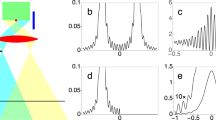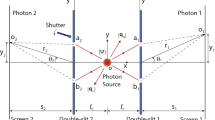Abstract
QUANTUM mechanics predicts that any detector capable of determining the path taken by a particle through a double slit will destroy the interference. This follows from the principle of complementarity formulated by Niels Bohr: simultaneous observation of wave and particle behaviour is prohibited. But such a description makes no reference to the physical mechanism by which the interference is lost. In the best studied welcher Weg (‘which path’) detection schemes1,2, interference is lost by the transfer of momentum to the particle whose path is being determined, the extent of momentum transfer satisfying the position–momentum uncertainty relation. This has prompted the question as to whether complementarity is always enforced in welcher Weg schemes by momentum transfer. Scully et al3. have recently responded in the negative, suggesting that complementarity must be accepted as an independent component of quantum mechanics, rather than as simply a consequence of the uncertainty principle. But we show here that, in any path detection scheme involving a fixed double slit, the amount of momentum transferred to the particle by a perfectly efficient detector (one capable of resolving the path unambiguously) is related to the slit separation in accordance with the uncertainty principle. If less momentum than this is transferred, interference is not completely destroyed and the path detector cannot be perfectly efficient.
This is a preview of subscription content, access via your institution
Access options
Subscribe to this journal
Receive 51 print issues and online access
$199.00 per year
only $3.90 per issue
Buy this article
- Purchase on Springer Link
- Instant access to full article PDF
Prices may be subject to local taxes which are calculated during checkout
Similar content being viewed by others
References
Bohr, N. in Albert Einstein: Philosopher-Scientist (ed. Schilpp, P. A.) 200–241 (Library of Living Philosophers, Evasion, 1949).
Feynman, R., Leighton, R. & Sands, M. The Feynman Lectures on Physics Vol. III Ch. 1 (Addison Wesley, Reading, 1965).
Scully, M. O., Englert, B.-G. & Walther, H. Nature 351, 111–116 (1991).
Storey, E. P., Collett, M. J. & Walls, D. F. Phys. Rev. A47, 405–418 (1993).
Arsac, J. Fourier Transforms and the Theory of Distributions Ch. 9.2 (Englewood Cliffs, Prentice Hall, 1966).
Tan, S. M. & Walls, D. F. Phys. Rev. A47, 4663–4676 (1993).
Bhandari, R. Phys. Rev. Lett. 69, 3720–3722 (1992).
Storey, E. P., Tan, S. M., Collett, M. J. & Walls, D. F. in Quantum Interferometry (eds De Martini, F., Zeilinger, A. & Denardo, G.) (World Scientific, Singapore, in the press).
Englert, B.-G., Schwinger, J. & Scully, M. O. in New Frontiers in Quantum Electrodynamics and Quantum Optics (ed. Barut, A. O.) 513–519 (Plenum, New York, 1990).
Author information
Authors and Affiliations
Rights and permissions
About this article
Cite this article
Storey, P., Tan, S., Collett, M. et al. Path detection and the uncertainty principle. Nature 367, 626–628 (1994). https://doi.org/10.1038/367626a0
Received:
Accepted:
Issue Date:
DOI: https://doi.org/10.1038/367626a0
This article is cited by
-
Epistemic Uncertainty from an Averaged Hamilton–Jacobi Formalism
Foundations of Physics (2022)
-
Maximizing Complementary Quantities by Projective Measurements
Brazilian Journal of Physics (2017)
-
Wave–Particle Duality: An Information-Based Approach
Foundations of Physics (2015)
-
A note on different definitions of momentum disturbance
Quantum Studies: Mathematics and Foundations (2015)
-
Equivalence of wave–particle duality to entropic uncertainty
Nature Communications (2014)
Comments
By submitting a comment you agree to abide by our Terms and Community Guidelines. If you find something abusive or that does not comply with our terms or guidelines please flag it as inappropriate.



